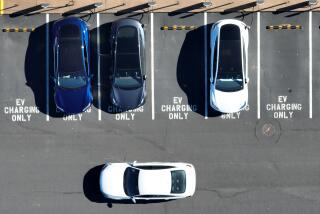Why the driverless car industry is happy (so far) with Trump’s pick for Transportation secretary

Reporting from San Francisco — Silicon Valley voted heavily for Hillary Clinton, but companies working on driverless cars seem overjoyed with President-elect Donald Trump’s nominee for Transportation secretary, Elaine Chao.
Chao will wield great power over how driverless cars and other automated vehicles will be regulated — or not.
Although she needs to be confirmed by the U.S. Senate first, she’s highly regarded in Washington, especially among Republicans, and her husband is Senate Majority Leader Mitch McConnell.
Moreover, as secretary of Labor under President George W. Bush, Chao was known not for the rules she crafted and enforced, but for her free-market approach that was generally hands-off.
For those in Silicon Valley and other tech firms where fears abound about too much government intervention and meddling, that’s a big relief.
“We expect the new administration to be pro-innovation, pro-American innovation and pro-American employment,” said Mike Jellen, president and chief operating officer of Velodyne Lidar, in reaction to Chao’s nomination.
Based in Morgan Hill, Velodyne is a major supplier of sophisticated sensors for driverless cars and trucks. Jellen believes enacting regulations to control advancing technology would impede innovation.
Others in the industry agree.
“We’d like to see her continue with her track record of light regulation,” said Grayson Brulte of Brulte & Co., an innovation advisory and consulting firm. “If she allows forward thinking entrepreneurs to build on the platforms that are autonomous vehicles, we’ll unleash an economic boom that will create huge numbers of jobs.”
Even consumer advocates offer cautious words of praise: “I’m concerned about her general anti-regulatory approach, but even though I disagree with her philosophy, I would say she is clearly qualified for the position,” said John Simpson, a director at Consumer Watchdog in Santa Monica.
Chao has served as a deputy secretary of transportation and was Labor secretary through Bush’s two terms, during which she pushed for less federal regulation and was criticized for allegedly not enforcing some regulations already on the books, such as overtime rules for wage earners. She describes herself at the top of her own homepage with a 2003 quote from Newsweek: “Elaine Chao – as slender as a stiletto, and as steely.”
She can’t approach automated vehicles as a deregulator — few federal regulations on driverless vehicles exist. Still, as automakers race to develop autonomous cars, the government faces big questions about how the vehicles will be adopted on a mass scale.
Safety is the biggest concern, and Chao must balance regulations that protect the public while avoiding those that impede innovation.
Today, some cars already come with semiautonomous features, such as Tesla and its Autopilot mode. As long as a driver is at the wheel to take control, federal laws put few limits on automation.
Federal law also says a car is not allowed on the road without a steering wheel or a brake pedal.
But at some point, those early rules could change.
Industry insiders say they don’t want Chao to ignore driverless car policy.
Instead, they hope to avoid a patchwork of differing and conflicting rules across the 50 states.
“This should be centralized,” said Alain L. Kornhauser, director of the transportation program at Princeton University and an autonomous vehicle expert, “but that doesn’t mean the states don’t play a part. It would be better if we had a common understanding.”
Although some had expected an aggressive regulatory approach from the Obama administration, it’s been mostly hands off under Transportation Secretary Anthony Foxx.
In September, the department issued a federal automated vehicles policy that set guidelines for driverless car developers and sought to balance safety and innovation.
It avoided hard-and-fast regulations while making clear that additional rules were likely to come as more was learned about the technology and its record of safety. The policy also listed “model” regulations for the states to consider. And it set out reporting requirements so government officials could stay on top of the industry’s problems and progress.
The Obama policy “is light-handed enough to provide enough flexibility for innovation,” Kornhauser said.
Bridget Karlin, managing director for the Internet of Things at chip maker Intel, called the Obama policy “an important first step and a milestone.”
Still, Karl Iagnemma, chief executive of NuTonomy, a driverless start-up, hopes Chao will cut back on paperwork requirements that, he believes, favor established companies. “If you’re a large organization, you may welcome a bit of regulation to keep the small guys out,” he said.
Regardless of whether Clinton or Trump won, the industry was ready to push for more clarity after the election, especially for real-world testing of driverless vehicles on public roads.
“We want [government] support to test these fleets as soon as possible,” said Velodyne’s Jellen. “Anything that promotes real world testing could really have a major impact on the development of this technology and on saving lives.”
States can allow driverless car testing on, say, a closed business campus or a dedicated highway lane.
Michigan and Florida are establishing rules and guidelines as they aggressively promote their states as test beds for driverless cars. Economic development is one motivator. In Florida, the state’s huge population of retired baby boomers is another highway safety concern.
California’s Department of Motor Vehicles put forward proposed regulations this year, drawing complaints from industry representatives who consider them prescriptive and heavy handed.
To promote flexibility and innovation, Michael Boehm, executive director of the E4 Advanced Transportation Center in Los Angeles, suggested the state allow regions to, in certain cases, set their own local policies for testing self-driving vehicles.
For instance, desperate to cut pollution and ease congestion, the Southland might be up for allowing driverless trucks to be tested on dedicated freeway lanes, whereas other regions might balk at the idea.
Hod Lipson, a professor at Columbia University, said setting a safety standard based on statistical goals, not specific technologies, should be Chao’s top priority.
The Department of Transportation “really needs to provide a clear definition of how safe a car needs to be before it can drive itself, and then step out of the way,” he said. “Once consumers are assured of safety, the ripple effect will begin. But until that safety standard is defined, everyone’s in the dark.”
Twitter: @russ1mitchell







